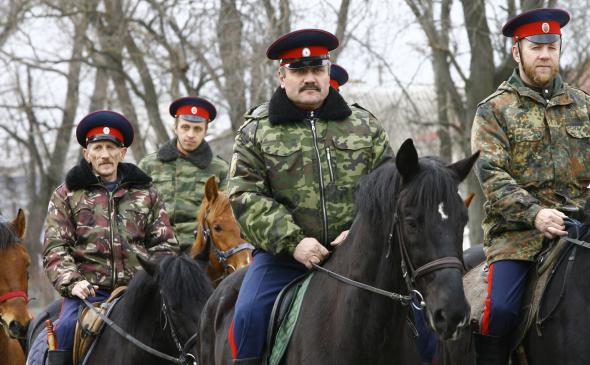
Putin’s Ten-Year War on the Real Cossacks
Publication: Eurasia Daily Monitor Volume: 15 Issue: 96
By:

Few in Russia or the West paid much attention to the Cossacks until a group of people claiming to be members attacked anti-Kremlin demonstrators, in Moscow, on May 5 (see EDM, May 17). Most Russians viewed them as fanciful revenants from the past; and most in the West, if they thought about the Cossacks at all, drew on Hollywood imagery about their supposed savagery against those who opposed the tsars more than a century ago.
But the Cossacks have long been problematic for the Russian state: both an asset and a threat. The tsarist authorities sought to regiment them, even though many Cossack hosts emerged as a result of flight from the imperial system and defined their members as a separate people of “free men.” The Soviets, from the outset, sought to eliminate them by exterminating many, driving others abroad, and destroying the economic, social and political arrangements that the Cossacks had worked out across the Russian Empire.
The Soviets succeeded in obliterating the infrastructure that supported the 13 Cossack hosts from the North Caucasus to the Russian Far East, fearful that the Cossacks would make territorial demands and concerned that their freedom-loving traditions would undermine Bolshevik efforts to build a totalitarian state. The authorities killed many, sent others to prison camps, and repopulated Cossack lands with ethnic Russians and non-Russians to create a situation in which the regime would have allies in the population against the Cossacks.
Most people assumed the Soviets had succeeded in their efforts to fully annihilate the Cossacks. The widespread belief was that Cossacks were only of academic interest, possibly a focus for historical reenactors, but not a subject of concern for Moscow. The last 25 years have proved otherwise (see Commentaries, November 25, 2013). When Soviet power collapsed, some Cossacks re-emerged and, often inspired by surviving Cossack communities in the West, demanded their rights be recognized, including to particular territories. The number of those who could trace their ancestry to the Cossacks was relatively small, certainly no more than a million. But as the Soviets had feared, the freedom-loving traditions of the historical Cossacks attracted many more people without such connections to their cause, leading to the rise of what, in the 1990s, came to be called “the neo-Cossacks.” These groups sprang up in all regions of the country, including places where Cossacks had never lived before. Some estimates suggest that their number now stands at five million or more (see EDM, July 13, 2016; March 28, 2017).
Over the last decade, Vladimir Putin has been engaged in a “war” of sorts against the Cossacks, suppressing genuine Cossacks, on the one hand, while on the other hand, exploiting alternative groups calling themselves Cossacks to carry out Kremlin policies at home and abroad. The Cossacks give Moscow a certain level of deniability. But by acting on the Russian state’s behalf in this way, these groups end up splintering and discrediting the Cossacks as a whole (see EDM, September 9, 2014; October 28, 2015; June 6, 2017).
According to Cossack historian Vladimir Melikhov, who himself has been persecuted in the past, Russian authorities in the last ten years arrested genuine Cossack leaders and closed down Cossack groups lest the Cossacks become a national movement and challenge Moscow’s control. Yet, at the same time, he points out, the Russian authorities have sought to make use of Cossacks to supplement the police. And as was seen on May 5, those Cossack groups have been utilized to carry out actions the Kremlin wants done but does not want to be blamed for (Facebook.com, June 11; Don-ataman.org, June 10).
Few of those with genuine Cossack roots, Melikhov notes, were prepared to play the Russian government’s game: they knew from their own history that the Kremlin was unlikely to remain their friend and supporter for long. It would use them and then toss them aside—and quite possibly try to destroy them once again. Moscow would certainly never recognize them as a nation or accept their rights to self-determination.
But many neo-Cossacks were all too willing to sign up with the Kremlin. They did not and do not know the history of the people they like to identify with; and their willingness to assist the Kremlin has served Putin well. It has simultaneously given him a group prepared to act as his bullyboys, and it has provided the Kremlin with yet another way to discredit the Cossacks in the West and even among Russians. After all, many both at home and abroad appear to accept the notion that Putin’s Cossacks are the direct descendants of Nicholas II’s Cossack forces. But in fact, those being utilized by today’s Kremlin have little in common with the pre-revolutionary groups, except for their fancy uniforms and nagaikas, the short whips for which some Cossacks are known.
Now, Putin has taken the logical next step. He has prepared a new law further blurring the distinction between real Cossacks and the regime’s “Cossack” enforces. This legislation will enable the Kremlin to continue to attack the former while exploiting the latter—a classic example of his approach (EurAsia Daily, June 17; Windowoneurasia2.blogspot.com, June 18). Putin will succeed if Russians and people in the West continue to confuse the two. But his approach may backfire if such confusion can be widely dispelled or if the real Cossacks become radicalized to the point of making ethnic and territorial demands that the Kremlin is unable and unwilling to meet.
For that reason, the most serious battles in the Russian government’s war on the Cossacks likely still lie ahead; and they are not necessarily fights Putin or his successors will win.



